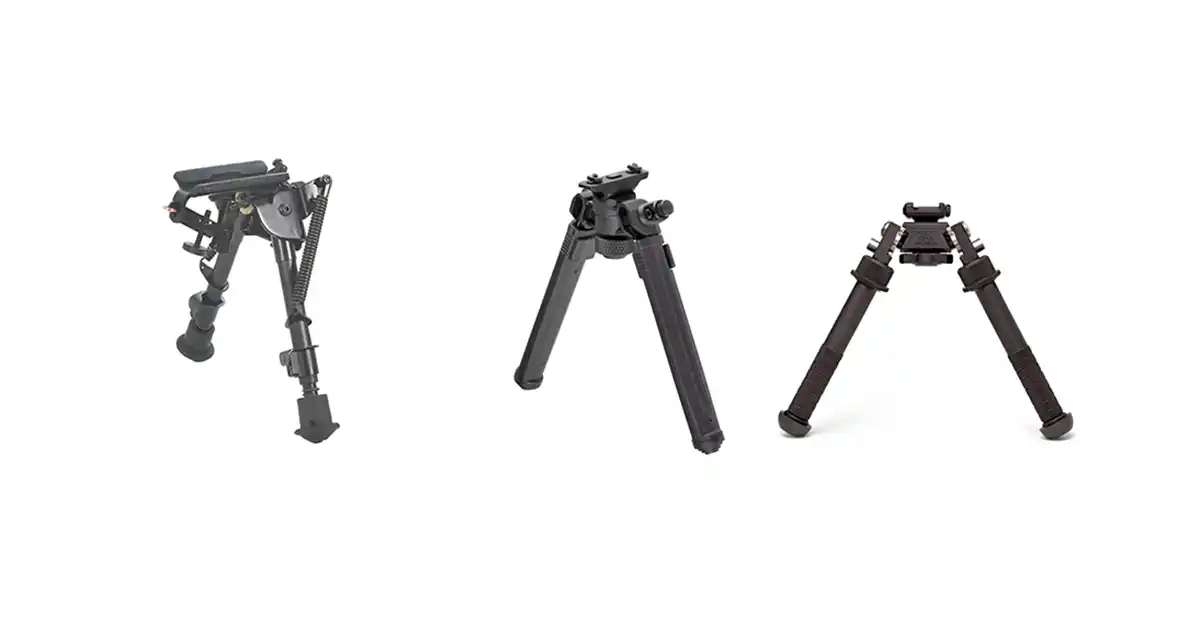Rifle bipods vary in price from about $25 to as much as $1,000. And they can be made from steel, aluminum, carbon fiber, polymer, or a mix of those materials. So when it comes to choosing the right one, it’s no surprise that it can be a bit overwhelming. To further complicate matters, there are many different mounting options. If there is an upside, it’s that many bipods do offer the same model in different mounts. And while I cannot tell you which bipod is best for your application, there’s an easy choice for probably 90% of most enthusiasts’ needs.
Why do you need a bipod?
It’s no secret that steadiness is one of the many components critical for accuracy. Being able to hold your iron sights or scope’s crosshairs on target is one of the keys to success. Shooting from a rest or a bag is great for that. They provide the stability necessary for long shots, or tight groups. But when hunting, plinking, or even in some competition, you can’t just bring your Lead Sled or front and rear bags. So the bipod is a portable solution for providing that stability.

Mounting options overview
This used to be pretty simple. Back in the day, rifle stocks generally had two or three studs on them. There was a rear one, and then a front one, which were used together to mount a sling. And just forward of the front one was a third stud for mounting a bipod. Of course, some stocks only had the studs for a sling, or a single one for a bipod, or were even shipped with none at all. But a couple of bucks and a few minutes with a drill, and your stock was ready for a bipod. Things aren’t so simple anymore.
Today, you can still find plenty of bipods using that mount. Other modern options include Picatinny mounts, M-LOK, KeyMod (is that still a thing?), and the latest, Arca mounts. The latter is one of the newest for firearms, and was adopted from the Arca-Swiss camera mount. Each has some pros and cons, and nearly all of them can be adapted to most rifles, although not always gracefully.
The basic stud
Not just the most common and oldest option, it’s also the simplest. If your stock doesn’t include one, they can be had for as little as $5, and are easily mounted in wood, wood laminates, and most polymer stocks. It’s not much more than a stud with a hole through it, and threads to attach to the stock. Pros: Your rifle probably already has one. No tools are required to install and remove. You can find the least expensive bipods in this mount, although there are also pricey options. Cons: Not the quickest to install and remove, and can’t really be repositioned. Ideal for field rifles and applications where the bipod is mounted semi-permanently.
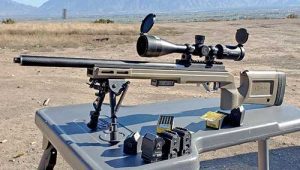
Picatinny
With aluminum or polymer stocks and chassis systems becoming more popular, it’s easy enough to attach a piece of Picatinny rail, if your rifle wasn’t already so-equipped. Available with one or two screws, or a quick-release lever, they mount securely. Pros: The QR versions can quickly be installed and removed, and if you have the rail space, repositioned with ease. Cons: The bolt-on ones are not quickly removed, unless your .308 blows up from an overcharged round. Then they fly right off. In all seriousness, the downside is mostly that this mount is becoming less popular due to M-LOK.
In the image below, the Magpul bipod is attached to a Picatinny rail section which mounts to the KRG Bravo chassis via M-LOK.

M-LOK
Magpul’s Modular Lock design is fairly new (it came out in 2014), and widely popular. It’s also widely ripped off, despite licensing being free. To be truly “M-LOK compatible”, companies must get a free license from Magpul, which is only to ensure proper spec for compatibility. Pretty much any major manufacturer will go through the trouble of licensing, to ensure their products interface correctly. If you see “M-LOK” on inexpensive Amazon and eBay products, that generally means they fit, but are neither licensed nor guaranteed to meet the actual specifications. They work, but can be prone to failure at the critical mount location.
Perhaps the biggest benefit of using licensed M-LOK products is the assurance of a good fit. They also mount solidly to both aluminum and polymer. And the slots are pretty ubiquitous on most firearms today. Cons? They can be a bit finicky to mount the first few times you use them. Tools are required, and there’s nothing fast about installation or removal.
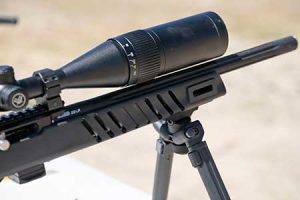
Arca mount
As mentioned, this is the newest mount for firearms. Adopted from camera mounts, the Arca plate is made to a specific standard, and generally includes a quick release. There is the Arca plate (or rail) that mounts to the stock or chassis, with the bipod itself having a clamp. It’s the least common, but certainly gaining traction. Highly popular for positional shooting, a long Arca rail allows the bipod to be moved fore and aft with a flick of the clamp. And with the clamp opened, it can easily be tipped off for removal. Pros: Fast on and off, and equally fast to reposition, as long as you have the rail space. Cons: It’s easy to spend around $100 just for a length of rail. And it’s popular, but still not super common compared to other mounts.
Bonus: An Arca plate or rail can be used on a tripod with an Arca-compatible head. That’s an Arca adapter on the underside of the chassis, below the scope bell.
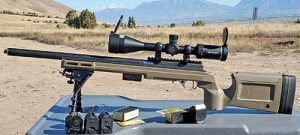
Materials
Steel is still one of the most common options because it’s inexpensive, easy to work with, and pretty robust. Aluminum is used as well, mostly for machined parts. Being softer than steel, it’s cheaper and easier to machine, although the material itself may be more expensive. Carbon fiber is used in applications where weight is a concern, and can get expensive. And the opposite of all the other options is polymer. Polymer is light, strong, can be molded or machined, and offers great strength for relatively low weight. As mentioned above, you are likely to find one or more of these materials in most bipods.
Options
The most basic bipod folds up and down, and may or may not have adjustable legs. After adjustable height legs, options really take off. How quickly and easily the legs deploy and adjust is just one of many functions. There are rubber feet, spiked feet, and feet that look like mini skis. Some bipods rotate on the horizontal plane (swivel) or tilt (cant) to compensate for uneven ground. They generally include a locking mechanism to either lock out movement, or add some friction so they can move, but not unintentionally. In the context of rimfire, features like legs that swing out front may or may not be useful.
Height options include 4-10″, 6-9″, and some taller or shorter options. Figure out which range you need, and go from there. About 6″ seems to be the sweet spot for a lot of my shooting.
Adapters
There are adapters to add a bipod stud to M-LOK or Picatinny mounts. And there are adapters that go over the stud to convert them to Picatinny. I’m sure someone makes one to go from the stud to M-LOK, I just haven’t seen it. Arca is sort of its own animal here. It’s possible to screw a long Arca rail to a wood or polymer stock, as well as attach one via M-LOK or Picatinny. In almost all cases, if there’s a will, there’s a way. But unless you have an expensive bipod not meant to natively mount on your rifle, then it’s best to avoid adapters if you can. Don’t add another expense, more complexity, or another point of failure, unless there’s no other feasible option.
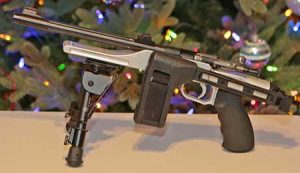
Bipods I use
Harris is known for making the most classic and recognizable bipod design. All metal, with springs that hold the legs in place. Easy to adjust, not too heavy, and absolutely gets the job done. My collection includes a single Harris, and probably half dozen copies. None of them were more than $100, and most were bought used for under $50. These are great for light rifles, as they are easy to load (leaning into them a bit for stability) and more than sturdy enough for most rimfires.
The only other brand I currently use is the Magpul, with mixed results. In my experience, they are great for heavier centerfire rifles, but their design doesn’t lend itself to lighter rimfire rifles. I do have a 10/22 pattern rifle in a KRG Bravo chassis with a stainless match barrel. It weighs 10.5 pounds, and the Magpul works very well with it. My gut tells me that the polymer design lacks the bit of springiness I find in the Harris style, so it doesn’t respond to loading quite the same.
Which is right for you?
I haven’t discussed prices, because they are all over the place. And I have only mentioned a few brands by name. But I can say that for any basic rimfire rifle that’s not being used for competition, the Harris-style is hard to be for both performance and price. Definitely the best value. That’s the one I recommend, and I’m pretty certain will work for most enthusiasts. And even the least expensive ones have been trouble-free for 10+ years. Many folks are happy with the Magpul bipods too, which are around the $100 mark as well. Again, I prefer them with heavier rifles.
If you’re competing, have a heavier rifle, or just hate money, then there are plenty of spendy options. Atlas and Warne are two well-known brands, with the former being one of two that make up the bulk of those used by top competitors (Harris is the other). Canadian brand MDT will be happy to take from $200 to $1,000 from you in exchange for one of their bipods. English company Tier One has some great options if you have $375-$705 burning a hole in your pocket. There are plenty of other brands out there too. Pick a mount, style, and budget, and start searching.
I’m sure I forgot some small detail or two, but this wasn’t meant to be a comprehensive overview of bipods. It’s more of a pre-buyer’s guide. Consider the popular options, your application, and your budget, and take this newfound knowledge with you on your search for the right bipod to suit your needs.
Click here to check rifle bipod prices at Opticsplanet.com
Click here to check rifle bipod prices at Amazon.com
